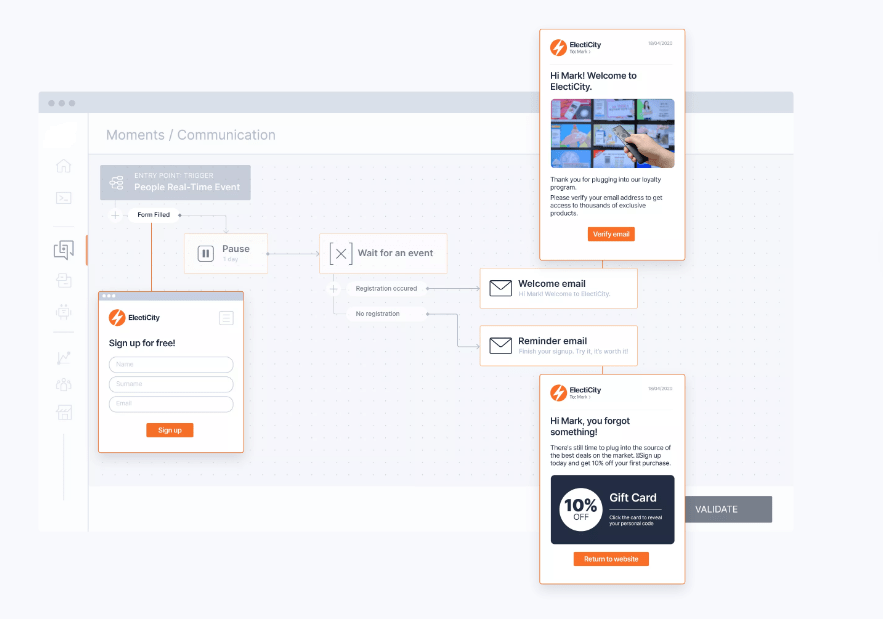As customer experience specialists, we have found that mapping customer journeys is a key component of creating effective automated marketing / service flows. Understanding the customer journey is essential for creating a personalised and seamless customer experience. In this article, we will explain the importance of journey maps, the process of creating them, and how to use them to create effective automated flows.
Understanding Customer Journeys
A customer journey is the path a customer takes to reach a specific goal or complete a task. It begins with the customer’s initial awareness of a product or service and ends with their final decision to purchase or not. Understanding the customer journey is critical for businesses because it helps them identify the touchpoints that customers encounter along the way and the factors that influence their decisions.
What is a Journey Map?
A journey map is a visual representation of the customer journey. It is a tool that businesses use to understand the customer experience and identify areas for improvement. A journey map can take many forms, from a simple flow chart to a more detailed infographic. The goal is to create a comprehensive view of the customer’s experience, including their emotions, thoughts, and behaviors.
Why are Journey Maps Important?
Journey maps are essential for businesses because they help them understand the customer experience and identify areas for improvement. By mapping the customer journey, businesses can identify pain points and opportunities for improvement. Journey maps also help businesses create a customer-centric approach, which is critical for creating a seamless and personalised customer experience.
The Process of Creating a Journey Map
Mapping the customer journey involves several steps, including:
- Defining the Customer Persona: The first step is to define the customer persona. This involves creating a detailed profile of the customer, including their demographics, behaviors, and preferences.
- Identifying Touchpoints: The second step is to identify the touchpoints that the customer encounters along the way. This includes both digital and physical touchpoints.
- Mapping the Journey: The third step is to map the customer journey. This involves creating a visual representation of the customer’s experience, including their emotions, thoughts, and behaviors.
- Identifying Pain Points: The fourth step is to identify the pain points that the customer encounters along the way. This includes any obstacles or challenges that the customer faces.
- Creating Solutions: The final step is to create solutions to address the pain points identified in the previous step. This involves designing an effective automated flow that addresses the customer’s needs and delivers a seamless experience.
Key Elements of a Journey Map
A journey map typically includes the following key elements:
- Persona: The persona is a detailed description of the customer, including their demographics, behaviors, and preferences.
- Touchpoints: Touchpoints are the interactions that the customer has with the business along the way.
- Emotions: Emotions are the feelings that the customer experiences throughout the journey.
- Behaviors: Behaviors are the actions that the customer takes along the way.
- Pain Points: Pain points are the obstacles or challenges that the customer encounters along the way.
- Solutions: Solutions are the strategies that the business uses to address the pain points and create a seamless customer experience.
Mapping Customer Journeys for Automated Flows
Mapping the customer journey is essential for creating effective automated flows. Automated flows are pre-determined sequences of actions that are triggered by specific customer behaviors or actions. By mapping the customer journey, businesses can identify the touchpoints that are most critical for triggering automated flows and design them to deliver a personalised and seamless customer experience.
Effective Automated Flows for Customer Journeys
Effective automated flows for customer journeys are those that are designed to deliver a personalised and seamless customer experience. They are triggered by specific customer behaviors or actions and deliver relevant content or offers based on the customer’s needs and preferences. Effective automated flows should be designed to be flexible and adaptable, allowing businesses to adjust them as needed to deliver the best possible customer experience.
Integrating Journey Maps with Our Marketing Automation Tools
Integrating journey maps with our Enterprise Platform is essential for creating effective automated flows. Marketing automation tools allow businesses to track customer behaviors and trigger automated flows based on specific actions. By installing a WebSDK we can monitor how a customer behaves on your website. For example, pages viewed, total site visits, duration on site, abandoned carts and more.
Measuring the Success of Automated Flows with Journey Maps
Measuring the success of automated flows with journey maps is essential for identifying areas for improvement. Using our branded custom URL shortener tool allows you to track not just how many clicks you get on a website link but ‘who’ is clicking. To track converted sales simply use a unique Google Analytics UTM link that sits behind our short link tool. When a customer clicks a link to your website to make a purchase you can track the amount and overall conversion rates.
Common Mistakes to Avoid When Mapping Customer Journeys
When mapping customer journeys, there are several common mistakes that businesses should avoid, including:
- Focusing too much on the technology: While technology is essential for creating effective automated flows, it should not be the sole focus. Businesses should also consider the customer’s needs and preferences when designing automated flows.
- Ignoring the customer’s emotions: Emotions play a critical role in the customer experience. Businesses should consider the customer’s emotions when designing automated flows and aim to deliver a personalised and empathetic customer experience.
- Not measuring the success of automated flows: Measuring the success of automated flows is critical for identifying areas for improvement. Businesses should track key metrics and use journey maps to identify pain points and opportunities for improvement.
Conclusion
Mapping customer journeys is essential for creating effective automated flows. By understanding the customer journey, businesses can identify pain points and opportunities for improvement. Journey maps can be used to create a personalised and seamless customer experience that delivers relevant content and offers at the right time. By integrating journey maps with marketing automation tools and measuring the success of automated flows, businesses can create a customer-centric approach that delivers results.




